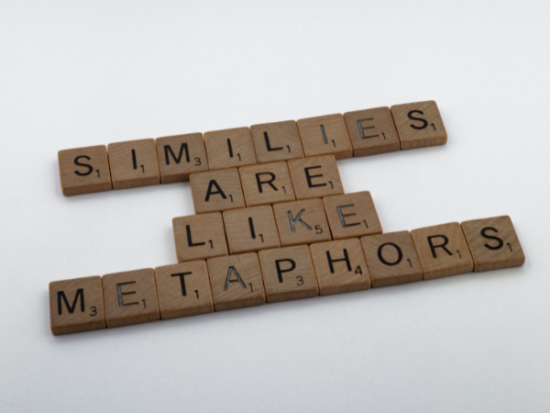Best figurative language examples to use in the real world
Whether you’re planning to write something, in particular, figurative language is what gives added color to your writing. With the assistance of figurative language, it will make dull and ordinary writings more insightful and effective. It helps draw attention to readers as it amplifies the thought of what you are trying to reach to your audience.
If you’re a teacher, a copywriter, or you’re in a business entity writing emails to your clients, figurative language can help you describe something by comparing it to something else. As you read along with this post, we’ll define what figurative language is, identify its importance, and give you examples of how it can help in your business.
What is figurative language?

Figurative languages are the words or phrases used to describe something through comparison to others. The use of words is playful and in a creative tone. But it doesn’t have a literal meaning. It incorporates allusions, metaphors, similes, and hyperboles to describe the object better.
Although sometimes it’s still an argument about how many types of figurative language there are, we’ll confirm that there are 12 types. Although it covers a wide range of literary devices, the main techniques revolve around these:
- Allusion
- Onomatopoeia
- Oxymoron
- Idiom
5 Major Branches
- Simile
- Metaphor
- Personification
- Symbolism
- Hyperbole
To help you better understand the concept. Here are the examples of the other remaining and a breakdown of the five common types of Figurative Language.
- He smiles like a Cheshire Cat (Allusion)
- Voice sounds – giggle, growl, shush, murmur, whine, whisper, blurt, and hiss (Onomatopoeia – imitates the sound)
- Small crowd, old news, and the living dead (Oxymoron)
- Stabbed in the back/Raining cats and dogs (Idiom)
1. Simile and examples
What is a simile? It compares two things and uses the word “like” or “as.” They are mostly used in normal daily conversations. Simile aims to stir an interesting connection in the mind of who you’re talking to.
Examples:
Sentence: The new coach is as tall as a giraffe.
Strong as an ox Clean as a whistle Busy as a bee Brave as a lion Clear as mud
2. Hyperbole and examples
Hyperbole is an excessive exaggeration that aims to prove a point. While it’s mostly funny or ridiculous, it brings out a sense of humor to the reader or the one listening. Though the exaggeration is outrageous, Hyperbole adds color to any statement or conversation.
Examples:
He snores like a freight train. I have told her a million times to clean the room. He’s so thin that the wind can carry him away. Today it’s so bright that even the sun would have to wear sunglasses.
3. Metaphor and examples
Metaphors denote a literary figure that seems deep that it doesn’t make sense. You would only understand them when you can fully grasp the connection between the words used in comparing two things.
One popular example is “Time is gold.” Time is not made of gold, but the value of time is as precious as gold.
Examples:
Love, you are my sunshine. The gladiator has a heart of stone, and he’s drowning in a sea of grief. My friend is undergoing a rollercoaster of emotions. Love is a battlefield.
4. Symbolism and examples
You’ll know its symbolism when a word has its definition but demonstrates something completely different. It’s like using art to represent an idea. This is normally used when authors want to show a certain emotion or mood.
Examples:
Inserting a red rose in your writings to show love Using an owl to symbolize wisdom Incorporating an apple pie to demonstrate a traditional American lifestyle Showing the image of the American flag to represent patriotism
5. Personification and examples
Personification is usually used in fiction, poetry, and rhymes, and it attributes human characteristics to inanimate animals, objects, or ideas. Using this figure of speech can broaden the reader’s imagination.
Examples:
The car halted with a screaming complaint. The TV stared at me. The sky was filled with thousands of dancing stars. Opportunity knocked at her door.
Why is figurative language important?
With the abstract nature of figurative language, one can communicate an idea that can be easily understood. Although this type of language doesn’t offer a direct meaning, it’s good to compare things or ideas. It makes it easier for the readers to visualize the concept you are trying to explain. We’ll lay out some of the reasons why figurative language is important.
Abstract becomes precise
While abstract emotions like love or sadness are difficult to describe, using figurative language can help convey your messages. Shakespeare’s famous line “love is blind” uses metaphor, indicating that love has eyes but isn’t capable of seeing.
This phrase cites that love can make one overlook mistakes or physical aspects. Incorporating figurative language will allow you to relay messages that are seemingly indescribable.
Excellent literary tools
Although figurative language presents itself in many literary forms, they are a great tool in improving linguistics. Take, for example, F. Scott Fitzgerald’s “The Great Gatsby” that used a simile in one of the lines in the book. “When she spoke, it sounded like gold coins clinking together.”
The line describes the character’s seeming promise of riches, and Fitzgerald has creatively used a metaphor in a descriptive phase. Not only does using figurative language give a whole lot of color to any writings, but it also makes any message interesting. Thus, sparking the reader’s or viewers’ interests.
Makes good impression
In advertising, you’ll notice that they often use figurative language whenever they promote a service or a product. Researchers in advertising learned that those who use figurative language in promotions have more successful campaigns than those who don’t. The use of figurative language in advertising leaves a positive impression on the consumers.
It gives out a clear image
Though there are many ways to describe something through writings, including visuals on them makes the description more concise. An Idiom is a source of imagery in American literature. For example, the idiomatic expression “a diamond in the rough” best describes a person with many potentials but lacks skills.
A diamond can only be dazzling once it’s cleaned, polished, and cut. The description becomes clear with how a diamond looks after and before it is cleaned, and Visuals made it clearer.
Related Articles
What are the best ways to use figurative language?
The five major types of figurative language are the most commonly used figures of speech, and they are essentials in an excellent writer’s kit. Keep in mind these rules on the best ways you can use them.
- Choose your figures of speech accordingly. Don’t use flowery simile or metaphors if such won’t enhance your story or explain the meaning of your work. Choose the correct figure of speech that best matches your fiction’s character or the one you’re addressing.
- Always consider the reason why you’re incorporating figurative language in your writings. Think of your fiction’s character. If it’s appropriate to hear such expressions based on their character, go for it. Why say “I’m in a sea of grief” if you say I’m sad or grieving. If it doesn’t fit the tone and style, skip it.
- Use your figures of speech lightly. If your paragraph is full of simile and metaphors, it’ll be hard to understand. Only use them if it delivers the right purpose. Or when the opportunity to include them calls for it.
Using these would be perfect whenever you want to express a meaning, theme, or boost any mood.
Key Takeaway
Whether you’re a writer or a language learner, understanding the concept of figurative language will help you enhance your writings. You’ll get to learn how to play with words and their meanings. If you want to get more familiar with the figurative language, read more of it first. Ernest Hemingway, Charles Dickens, and Thomas Wolfe hold some of the best ways figurative language is written.




